2023 HYUNDAI IONIQ 6 emergency towing
[x] Cancel search: emergency towingPage 290 of 582
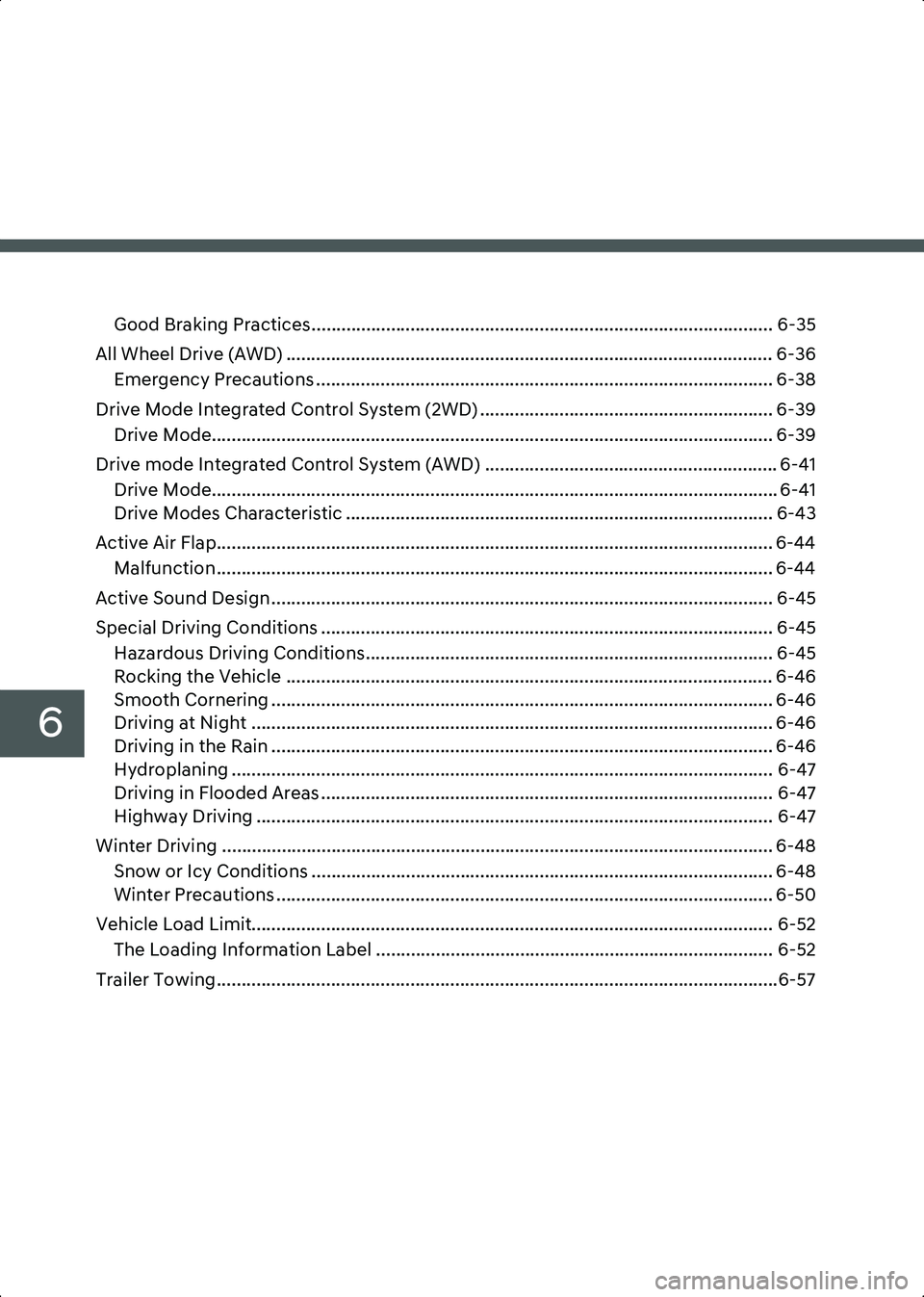
6
Good Braking Practices............................................................................................. 6-35
All Wheel Drive (AWD) .................................................................................................. 6-36 Emergency Precautions ............................................................................................ 6-38
Drive Mode Integrated Control System (2WD) ........................................................... 6-39 Drive Mode................................................................................................................. 6-39
Drive mode Integrated Control System (AWD) ........................................................... 6-41 Drive Mode.................................................................................................................. 6-41
Drive Modes Characteristic ...................................................................................... 6-43
Active Air Flap................................................................................................................ 6-44 Malfunction................................................................................................................ 6-44
Active Sound Design..................................................................................................... 6-45
Special Driving Conditions ........................................................................................... 6-45 Hazardous Driving Conditions.................................................................................. 6-45
Rocking the Vehicle .................................................................................................. 6-46
Smooth Cornering ..................................................................................................... 6-46
Driving at Night ......................................................................................................... 6-46
Driving in the Rain ..................................................................................................... 6-46
Hydroplaning ............................................................................................................. 6-47
Driving in Flooded Areas ........................................................................................... 6-47
Highway Driving ........................................................................................................ 6-47
Winter Driving ............................................................................................................... 6-48 Snow or Icy Conditions ............................................................................................. 6-48
Winter Precautions .................................................................................................... 6-50
Vehicle Load Limit......................................................................................................... 6-52 The Loading Information Label ................................................................................ 6-52
Trailer Towing ................................................................................................................. 6-57
Hyundai_CE_en_US.book Page 2
Page 326 of 582

Driving Your Vehicle
6-38
CAUTION Always drive slowly in water. If you drive
too fast, water may get into the motor
compartment, causing your vehicle to
suddenly stop.
Additional driving conditions
• Become familiar with the off-road conditions before driving.
• Always pay attention when driving off-road and avoid dangerous areas.
• Drive slowly when driving in heavy wind.
• Reduce vehicle speed when cornering. The center of gravity of AWD vehicles is
higher than conventional 2WD vehicles,
making them more likely to roll over
when you rapidly turn corners.
• Always hold the steering wheel firmly when you are driving off-road.
WARNING Do not grab the inside of the steering
wheel when you are driving off-road. You
may hurt your arm by a sudden steering
maneuver or from steering wheel
rebound due to an impact with objects on
the ground. You could lose control of the
steering wheel which may lead to serious
injury or death.
Emergency Precautions
Tires
When replacing tires, be sure to equip all
four tires with the same size, type, tread
patterns, brand and load-carrying
capacity.
WARNING Do not use tire and wheel with different
size and type from the one originally
installed on your vehicle. It can affect the
safety and performance of your vehicle,
which could lead to steering failure or
rollover causing serious injury.
WARNING
B6005201
Never start or run the vehicle while an
AWD vehicle is raised on a jack. The
vehicle can slip or roll off of a jack causing
serious injury or death to you or those
nearby.
Towing
AWD vehicles must be towed with a
wheel lift and dollies or flatbed
equipment with all the wheels off the
ground. For more information, refer to the
"Towing" section in chapter 8.
Vehicle inspection
• If the vehicle needs to be operated on a vehicle lift do not attempt to stop any of
the four wheels from turning. This could
damage the AWD system.
• Never engage the parking brake while running the vehicle on a car lift. This
may damage the AWD system.
Hyundai_CE_en_US.book Page 38
Page 497 of 582

8
8. Emergency Situations
Hazard Warning Flasher .................................................................................................. 8-2
In Case of an Emergency While Driving......................................................................... 8-2If the Vehicle Stalls While Driving ............................................................................... 8-2
If the Vehicle Stalls at A Crossroad or Crossing......................................................... 8-2
If You Have a Flat Tire While Driving .......................................................................... 8-2
If the Vehicle Will Not Start............................................................................................. 8-3 Confirm the EV Battery is not Low on the Charge Gauge......................................... 8-3
Jump Starting (12 V battery) ...........................................................................................8-4
Tire Pressure Monitoring System (TPMS) ...................................................................... 8-7 Check Tire Pressure ..................................................................................................... 8-7
Tire Pressure Monitoring System................................................................................8-8Low Tire Pressure Warning Light ................................................................................8-9Low Tire Pressure Position and Tire Pressure Telltale ...............................................8-9Changing a Tire with TPMS ....................................................................................... 8-10
If You Have a Flat Tire (with Tire Mobility Kit) ..............................................................8-12 Introduction.................................................................................................................8-12
Notes on the Safe Use of the Tire Mobility Kit ......................................................... 8-13
Components of the Tire Mobility Kit ........................................................................ 8-14
Using the Tire Mobility Kit When a Tire is Flat ......................................................... 8-15
How to Adjust Tire Pressure .......................................................................................8-17
Towing ............................................................................................................................ 8-18 Towing Service ........................................................................................................... 8-18
Removable Towing Hook .......................................................................................... 8-19
Hyundai_CE_en_US.book Page 1
Page 500 of 582

Emergency Situations
8-4
Jump Starting (12 V
battery)
Jump starting can be dangerous if done
incorrectly. Follow the jump starting
procedure in this section to avoid serious
injury or damage to your vehicle. If in
doubt about how to properly jump start
your vehicle, have a service technician or
towing service do it for you.
WARNING To prevent SERIOUS INJURY or DEATH to
you or bystanders, always follow these
precautions when working near or
handling the battery:
Always read and follow instructions
carefully when handling a battery.
Wear eye protection designed to protect
the eyes from acid splashes.
Keep all flames, sparks, or smoking
materials away from the battery.Hydrogen gas is always present in battery
cells. It is highly combustible, and may
explode if ignited.
Keep batteries out of reach of children.
Batteries contain sulfuric acid that is
highly corrosive. Do not allow acid to
contact your eyes, skin, or clothing. If acid
gets into your eyes, flush your eyes with
clean water for at least 15 minutes and get
immediate medical attention. If acid gets
on your skin, thoroughly wash the area. If
you feel pain or a burning sensation, get
medical attention immediately.
• When lifting a plastic-cased battery,
excessive pressure on the case may
cause battery acid to leak. Lift with a
battery carrier or with your hands on
opposite corners.
• Do not attempt to jump start your vehicle if your battery is frozen.
• NEVER attempt to recharge the battery when the vehicle’s battery cables are
connected to the battery.
Hyundai_CE_en_US.book Page 4
Page 512 of 582
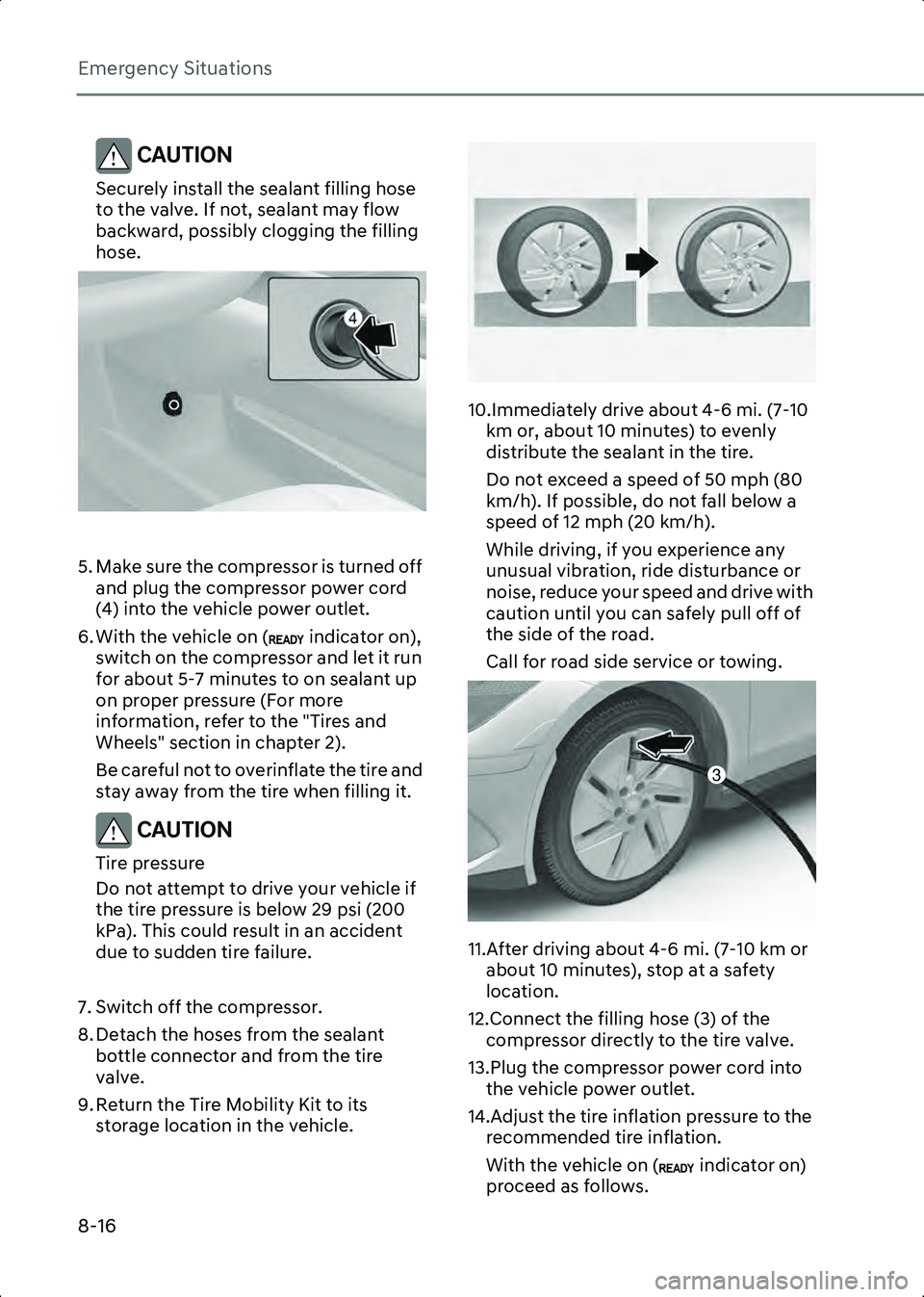
Emergency Situations
8-16
CAUTION Securely install the sealant filling hose
to the valve. If not, sealant may flow
backward, possibly clogging the filling
hose.
B8002507
5. Make sure the compressor is turned off and plug the compressor power cord
(4) into the vehicle power outlet.
6. With the vehicle on ( indicator on), switch on the compressor and let it run
for about 5-7 minutes to on sealant up
on proper pressure (For more
information, refer to the "Tires and
Wheels" section in chapter 2).
Be careful not to overinflate the tire and
stay away from the tire when filling it.
CAUTION Tire pressure
Do not attempt to drive your vehicle if
the tire pressure is below 29 psi (200
kPa). This could result in an accident
due to sudden tire failure.
7. Switch off the compressor.
8. Detach the hoses from the sealant bottle connector and from the tire
valve.
9. Return the Tire Mobility Kit to its storage location in the vehicle.
B8002508
10.Immediately drive about 4-6 mi. (7-10 km or, about 10 minutes) to evenly
distribute the sealant in the tire.
Do not exceed a speed of 50 mph (80
km/h). If possible, do not fall below a
speed of 12 mph (20 km/h).
While driving, if you experience any
unusual vibration, ride disturbance or
noise, reduce your speed and drive with
caution until you can safely pull off of
the side of the road.
Call for road side service or towing.
B8002509
11.After driving about 4-6 mi. (7-10 km or about 10 minutes), stop at a safety
location.
12.Connect the filling hose (3) of the compressor directly to the tire valve.
13.Plug the compressor power cord into the vehicle power outlet.
14.Adjust the tire inflation pressure to the recommended tire inflation.
With the vehicle on ( indicator on)
proceed as follows.
3
Hyundai_CE_en_US.book Page 16
Page 514 of 582
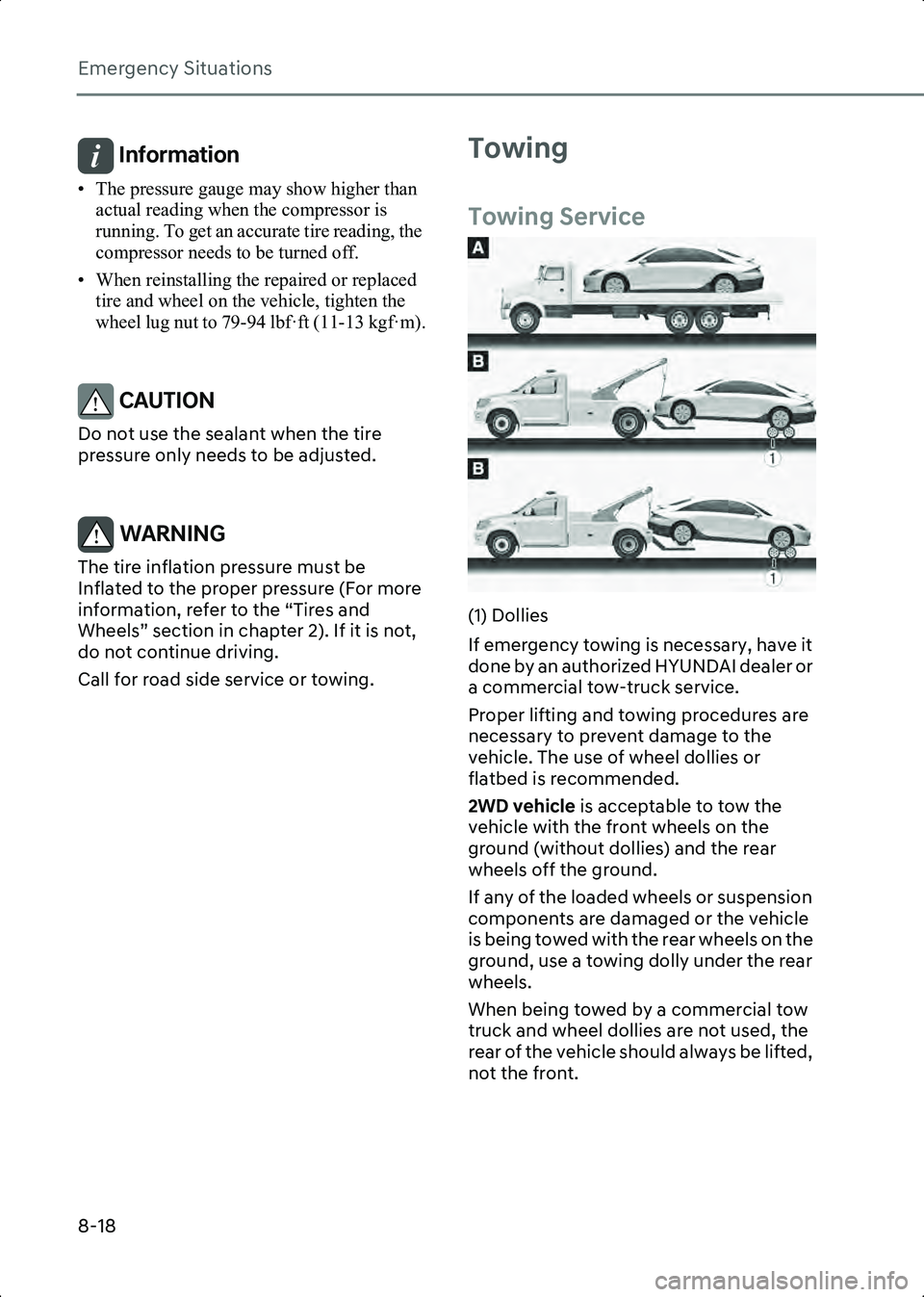
Emergency Situations
8-18
Information • The pressure gauge may show higher than actual reading when the compressor is
running. To get an accurate tire reading, the
compressor needs to be turned off.
• When reinstalling the repaired or replaced tire and wheel on the vehicle, tighten the
wheel lug nut to 79-94 lbf·ft (11-13 kgf·m).
CAUTION Do not use the sealant when the tire
pressure only needs to be adjusted.
WARNING The tire inflation pressure must be
Inflated to the proper pressure (For more
information, refer to the “Tires and
Wheels” section in chapter 2). If it is not,
do not continue driving.
Call for road side service or towing.
Towing
Towing Service
B8002701(1) Dollies
If emergency towing is necessary, have it
done by an authorized HYUNDAI dealer or
a commercial tow-truck service.
Proper lifting and towing procedures are
necessary to prevent damage to the
vehicle. The use of wheel dollies or
flatbed is recommended.
2WD vehicle is acceptable to tow the
vehicle with the front wheels on the
ground (without dollies) and the rear
wheels off the ground.
If any of the loaded wheels or suspension
components are damaged or the vehicle
is being towed with the rear wheels on the
ground, use a towing dolly under the rear
wheels.
When being towed by a commercial tow
truck and wheel dollies are not used, the
rear of the vehicle should always be lifted,
not the front.
Hyundai_CE_en_US.book Page 18
Page 516 of 582
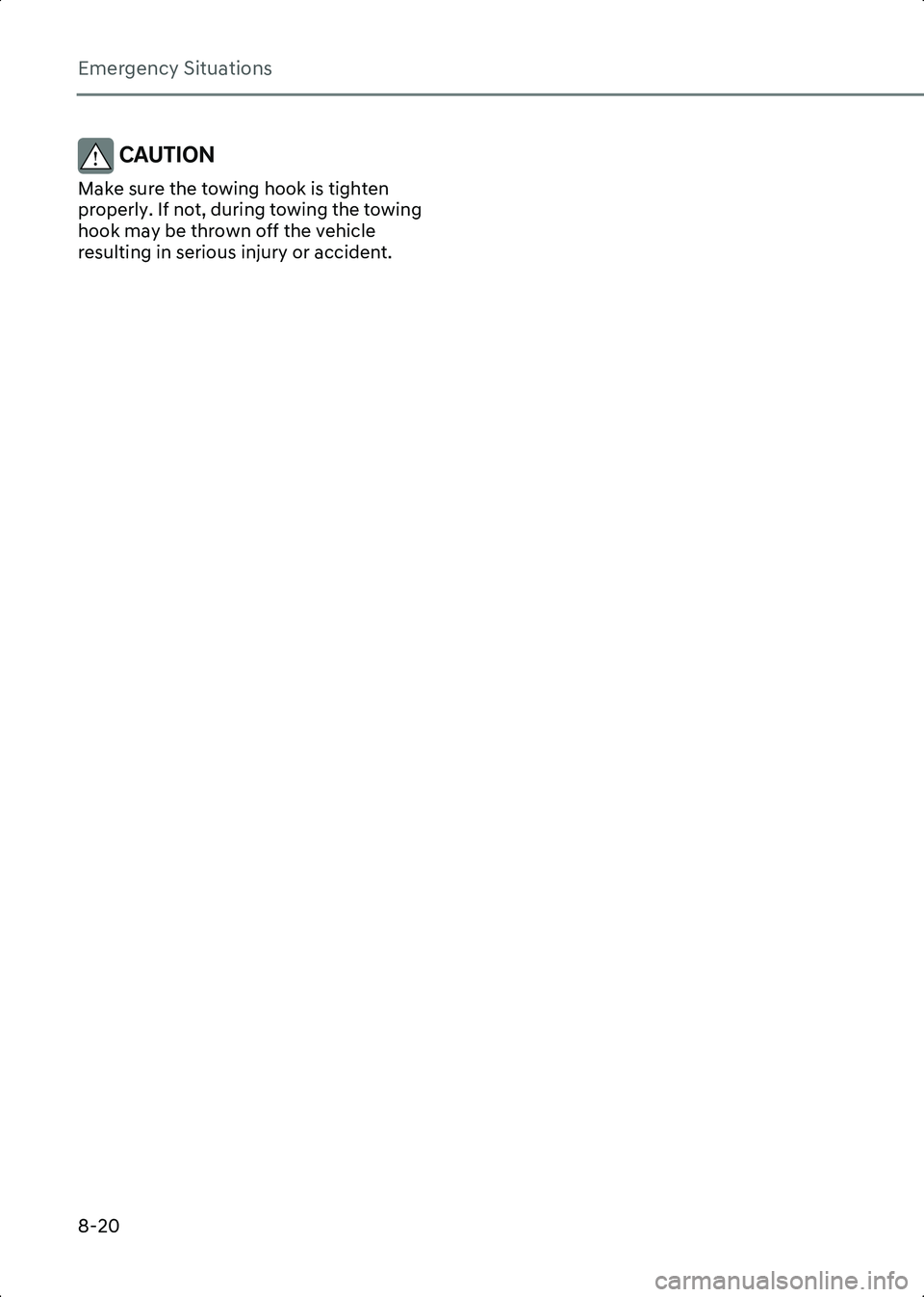
Emergency Situations
8-20
CAUTION Make sure the towing hook is tighten
properly. If not, during towing the towing
hook may be thrown off the vehicle
resulting in serious injury or accident.
Hyundai_CE_en_US.book Page 20
Page 574 of 582
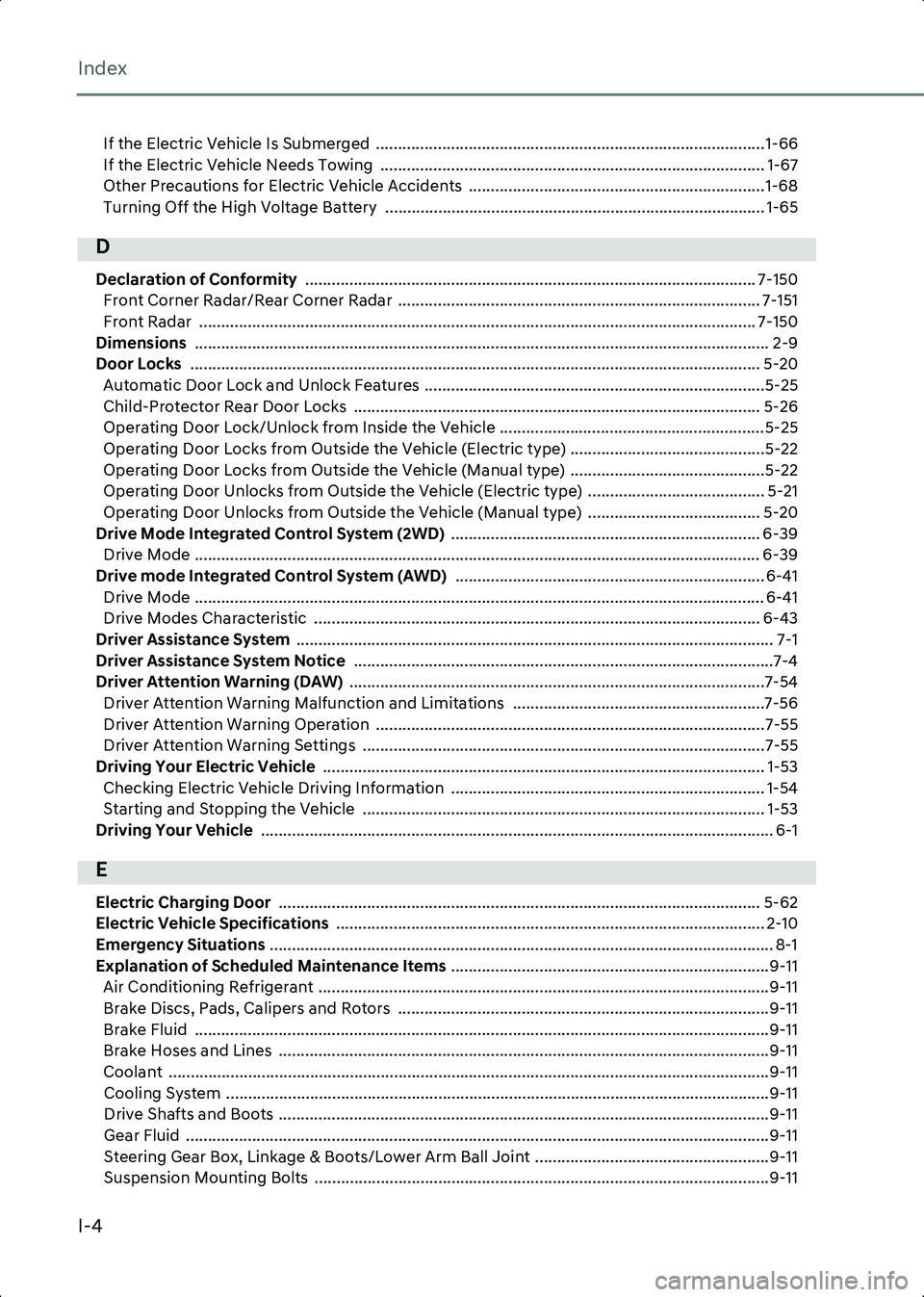
Index
I-4
If the Electric Vehicle Is Submerged ........................................................................................1-66
If the Electric Vehicle Needs Towing ....................................................................................... 1-67
Other Precautions for Electric Vehicle Accidents ................................................................... 1-68
Turning Off the High Voltage Battery ...................................................................................... 1-65
D
Declaration of Conformity ...................................................................................................... 7-150Front Corner Radar/Rear Corner Radar .................................................................................. 7-151
Front Radar .............................................................................................................................. 7-150
Dimensions .................................................................................................................................. 2-9
Door Locks ................................................................................................................................. 5-20
Automatic Door Lock and Unlock Features .............................................................................5-25
Child-Protector Rear Door Locks ............................................................................................ 5-26
Operating Door Lock/Unlock from Inside the Vehicle ............................................................5-25
Operating Door Locks from Outside the Vehicle (Electric type) ............................................5-22
Operating Door Locks from Outside the Vehicle (Manual type) ............................................5-22
Operating Door Unlocks from Outside the Vehicle (Electric type) ........................................ 5-21
Operating Door Unlocks from Outside the Vehicle (Manual type) ....................................... 5-20
Drive Mode Integrated Control System (2WD) ...................................................................... 6-39
Drive Mode ................................................................................................................................ 6-39
Drive mode Integrated Control System (AWD) ...................................................................... 6-41
Drive Mode ................................................................................................................................. 6-41
Drive Modes Characteristic ..................................................................................................... 6-43
Driver Assistance System ............................................................................................................ 7-1
Driver Assistance System Notice ...............................................................................................7-4
Driver Attention Warning (DAW) ..............................................................................................7-54
Driver Attention Warning Malfunction and Limitations .........................................................7-56
Driver Attention Warning Operation ........................................................................................7-55
Driver Attention Warning Settings ...........................................................................................7-55
Driving Your Electric Vehicle .................................................................................................... 1-53
Checking Electric Vehicle Driving Information ....................................................................... 1-54
Starting and Stopping the Vehicle ........................................................................................... 1-53
Driving Your Vehicle .................................................................................................................... 6-1
E
Electric Charging Door ............................................................................................................. 5-62
Electric Vehicle Specifications ................................................................................................. 2-10
Emergency Situations .................................................................................................................. 8-1
Explanation of Scheduled Maintenance Items ........................................................................9-11
Air Conditioning Refrigerant ......................................................................................................9-11 Brake Discs, Pads, Calipers and Rotors ....................................................................................9-11
Brake Fluid ..................................................................................................................................9-11
Brake Hoses and Lines ...............................................................................................................9-11
Coolant ........................................................................................................................................9-11Cooling System ...........................................................................................................................9-11
Drive Shafts and Boots ...............................................................................................................9-11
Gear Fluid ....................................................................................................................................9-11
Steering Gear Box, Linkage & Boots/Lower Arm Ball Joint .....................................................9-11Suspension Mounting Bolts .......................................................................................................9-11
Hyundai_CE_en_US.book Page 4